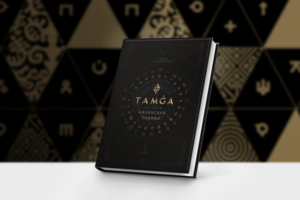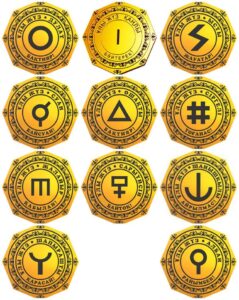ASTANA – Amid growing demand for national identity reflection and reassessment, the new book “Tamga: History of Kazakh Tribes” written by historian Radik Temirgaliyev presents an opportunity to explore Kazakh tribal heritage beyond myth and preconceptions. The finely crafted historical book was presented on Dec. 12 in Astana during a meeting with the author organized by the Paperlab research center.

Moderator Serik Beyssembayev and historian and author Radik Temirgaliyev. Photo credit: Aibarshyn Akhmetkali/The Astana Times
With evocative accuracy, Temirgaliyev gathers a broad historical context for each tribe, suggesting that Kazakh history is incomplete without understanding the tribal segregation and the impact that it had on the building of the nation and its identity.
Kazakh tribal identity
At its most basic level, people’s identity is composed of first name, last name, gender, and nationality, but beyond that, Kazakhs, historically, have placed an important role in their tribal identity as well. For centuries, knowing one’s tribe, along with seven generations from paternal lineage, was an important step in developing self-identity and was considered a tribute to ancestors. To the extent that not being aware of one’s tribal affiliation brought a sense of embarrassment.

Book cover. Photo credit: meloman.kz
“Each member of the tribe had to know his ancestry well. A child who had barely learned to speak was required by any adult to list his seven male ancestors, as well as to name his tribe, clan and sub-clan without stammering. Those who failed to answer properly, together with their parents, became victims of merciless steppe wit,” wrote Temirgaliyev in the preface of his book.
“The importance of shezhire (genealogic tree) was due to the fact that it was vital information. This knowledge strongly linked the kin to each other while at the same time helping to establish common ground in dialogue with other tribal communities,” he added.
The significance of tribal identity remains deeply ingrained in various regions of Kazakhstan. Many Kazakhs derive pride from the historical accomplishments of their tribes and the prominent historical figures associated with them.
How were tribes formed?
The Kazakh tribes were formed from the traditional nomadic grounds. According to Temirgaliyev, what needs to be understood is that unlike sedimentary communities of farmers, often fragmented into small groups that very rarely interacted with neighboring settlements, nomads were dependent on forming alliances as a means of preserving their nomadic lifestyle.

The Great Zhuz tribes marked by red color had a regular presence in the Zhetisu Region and southern Kazakhstan. The Middle Zhuz tribes, marked by orange, were based in eastern, central and northern Kazakhstan, while the Small Zhuz (green color) occupied the territory of western Kazakhstan. Photo credit: wikipedia.org
“Nomadic cattle breeding in the harsh steppe conditions pushed people to form quite numerous and cohesive associations. Firstly, it was required by the necessity to protect property. Domestic cattle have always been very attractive prey for dashing people and predatory animals. Secondly, cattle breeding was associated with cyclic crisеs – mass death of animals due to natural disasters or epidemics. Without periodic redistribution of livestock, long-term and successful farming was impossible,” wrote Temirgaliyev.
“These and other important objective circumstances contributed to the preservation of strong ties between rather distant (by the standards of farmers) kin. Large families turned into clans, clans into tribes,” he added.

The marks and mottos of the Great zhuz tribes. Photo credit: Facebook at Nomads of the Great steppe.
In popular legend, the origin of the tribes can be traced back to the Alasha Khan, the first sole ruler of all Kazakhs. According to the legend, all Kazakhs were recognized as descendants of three hundred warriors united under the Alasha khan, a shared ancestor.
The Kazakh tribes unite under three main alliances named zhuz: the Great Zhuz, the Middle Zhuz and the Small Zhuz. Within the Great Zhuz, there are tribes such as Zhalaiyr, Ysty, Alban, Suan and Dulat, while the Middle Zhuz includes Argyn, Naiman, Kypshak, and Konyrat. Within the Small Zhuz, there are Alshyn and Zhetiru tribes.
The concept of zhuzes reflects the historical organization of the Kazakh nomadic society and its emphasis on kinship and unity.
Each tribe has its tamga (mark) and uran (motto). They occupy different territories of Kazakhstan. For example, the Great Zhuz tribes had a regular presence in the Zhetisu Region and southern Kazakhstan. The Middle Zhuz tribes were based in eastern, central and northern Kazakhstan, while the Small Zhuz occupied the territory of western Kazakhstan.
Characteristics of tribes
Each of the three zhuzes and their respective tribes exhibits distinct characteristics in the personalities of their members, traits that persist among Kazakhs to this day.
“Give the Great Zhuz a stick to herd cattle, give the Middle Zhuz a feather to rule, give the Small Zhuz a spear and put it against the enemy,” says the famous Kazakh folk wisdom.
Temirgaliyev attributes these characteristics to the specific territories and occupations associated with each tribe.
“Each region occupied some geographical and climatic zone that determined the nature of the economy, the nature of the occupations, what these people would do,” said Temirgaliyev.
“For example, the belligerence of the Small Zhuz was largely due to the fact that they did not have enough resources. They possessed not so many cattle; they lived in a semi-desert zone, where you had to drink from wells – it was very hard labor. The sizes of their herds were smaller, therefore the so-called ‘raid economy’ played a big role,” he added.
Another example is the Kerey tribe from the Middle Zhuz, who inhabited the lush forests of northern Kazakhstan.
“When they say that the Kereys are masters of wood, look at the lands occupied by the Kereys. This is precisely northern Kazakhstan. It is the forests, it is an opportunity to produce. Therefore, the Kereys were famous as carpenters, they made better yurts, and the whole steppe bought yurts from them,” said Temirgaliyev.
In any given tribe, there will be a full range of complexions, but they are all united in a deep sense of belonging to one nationality.
The relevance of the book
Most of the modern telling of the tribal history and origins is largely unverified or is based on consonance with English or Francophone words that form a very loose base for deriving conclusions. Given the vastness of the material about Kazakh tribes, Temirgaliyev decided to focus on the period starting from the 13th-15th centuries.
“I put emphasis more on the later period, the Golden-Horde-Kazakh period, when we already have sources, we have such a base, where we can speak with confidence and fantasize less,” said Temirgaliyev.
The Kazakh sources are being included in narratives of the tribal history that once only told the Russian side of the story.
“I have cited quite a lot of materials if you have paid attention. I used a lot of works of Mashkur Zhusup Kopeev, Shakarim [Kudaiberdiuly], Kurbangali Khalidi in different chapters. It seems to me this is probably the first work in which so many Kazakh sources and materials were used,” said Temirgaliyev.
The book is a powerful companion to many previous works by prominent historians and ethnographers such as Shokan Ualikhanov, Nikolay Aristov and Mukhamedzhan Tynyshpaeyev.
By embracing education through such historical books, one can start to break down some of the stereotypes around Kazakh tribal identity. This is not tribalism in the narrow sense but rather a group passion for a common ideology that allows these subgroup identities to thrive while being bound by an overarching collective identity of Kazakh nationality.

